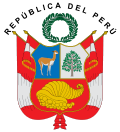- Constitution of Peru
-
Peru 
This article is part of the series:
Politics and government of
PeruExecutive PowerJudicial PowerLegislative PowerAuton. institutionsElectionsPolitical partiesRegional gov'tsLocal gov'ts
The Constitution of Peru is the supreme law of Peru. The current constitution, enacted on December 31, 1993, is Peru's fifth in the 20th century and replaced the 1979 Constitution.[1] The Constitution was drafted by the Democratic Constitutional Congress that was convened by President Alberto Fujimori during the Peruvian Constitutional Crisis of 1992 that followed his 1992 dissolution of Congress, was promulgated on December 29, 1993. A Democratic Constitutional Congress (CCD) was elected in 1992, and the final text was approved under a referendum.
The current Constitution of Peru differs from the 1979 Constitution in that it gives greater power to the president. For example, it allowed for reelection, reduced the bicameral 240-member congress to a unicameral 120 Congress of the Republic,[2] not only affirmed the president's power to veto found in the 1979 Constitution, but also gave him the power to use a line item veto, and mandated that all tax laws receive prior approval by the Ministry of Economics and Finance. While the Constitution of 1979 allowed the president to dissolve congress after congress censured cabinet members three times, the current constitution allows the president to do so after only two censures. The Constitution allows the president to decree laws as long as he first informs the Congress of his intent to do so. If the president dissolves congress, the Constitution gives him the power to rule until the election of a new Congress within a four month timeline, during which time the Standing Committee of the dissolved Congress will remain functioning.
Contents
1979 Constitution
The 1979 Constitution was promulgated on July 12, 1979 by a Constituent Assembly elected in June 1978 following 10 years of military rule and replaced the suspended 1933 Constitution. It became effective in 1980 with the re-election of deposed President Fernando Belaúnde Terry. It limited the president to a single five-year term and established a bicameral legislature consisting of a 60-member Senate (upper house) and a 180-member Chamber of Deputies (lower house). It also eliminated the literacy requirement for voting and extended suffrage to all adults 18 or older.[2]
See also
- Constitutional economics
- Constitutionalism
- Rule according to higher law
References
- ^ Economist Intelligence Unit (2005-01-12). "Country Briefings: Peru – Political forces". The Economist. http://www.economist.com/countries/Peru/profile.cfm?folder=Profile-Political%20Forces. Retrieved 2007-02-23.
- ^ a b "Peru: Government". Encyclopedia of the Nations – Americas. Thomson Gale. 2006. http://www.nationsencyclopedia.com/Americas/Peru-GOVERNMENT.html. Retrieved 2007-02-23.
External links
- (Spanish) The Constitution of Peru
- (Spanish) Full text of each of Peru's historic constitutions
Constitutions of states and dependencies in the Americas North America · South America Sovereign states - Antigua and Barbuda
- Argentina
- Bahamas
- Barbados
- Belize
- Bolivia
- Brazil
- Canada
- Chile
- Colombia
- Costa Rica
- Cuba
- Dominica
- Dominican Republic
- Ecuador
- El Salvador
- Grenada
- Guatemala
- Guyana
- Haiti
- Honduras
- Jamaica
- Mexico
- Nicaragua
- Panama
- Paraguay
- Peru
- Saint Kitts and Nevis
- Saint Lucia
- Saint Vincent and the Grenadines
- Suriname
- Trinidad and Tobago
- United States
- Uruguay
- Venezuela

Dependencies and
other territories- Anguilla
- Aruba
- Bermuda
- Bonaire
- British Virgin Islands
- Cayman Islands
- Curaçao
- Falkland Islands
- French Guiana
- Greenland
- Guadeloupe
- Martinique
- Montserrat
- Navassa Island
- Puerto Rico
- Saint Barthélemy
- Saint Martin
- Saint Pierre and Miquelon
- Saba
- Sint Eustatius
- Sint Maarten
- South Georgia and the South Sandwich Islands
- Turks and Caicos Islands
- US Virgin Islands
Categories:- Constitutions by country
- Peruvian legislation
Wikimedia Foundation. 2010.
